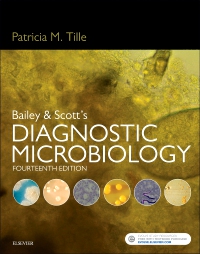
Bailey & Scott's Diagnostic Microbiology - Elsevier eBook on VitalSource, 14th Edition
Elsevier eBook on VitalSource

Develop your students’ lab skills with the gold standard in microbiology! Serving as both the #1 bench reference for practicing microbiologists and as a favorite text for students in clinical laboratory science programs, Bailey & Scott’s Diagnostic Microbiology, 14th Edition covers all the information and critical thinking practice students need for effective laboratory testing. This new edition features hundreds step-by-step procedures, updated visuals, new case studies, and updated material on the latest trends and equipment in clinical microbiology — including automation, automated streaking, MALDI-TOF, and incubator microscopes. This reference also comes with a significantly revised lab manual, and expanded sections on parasitology, mycology, and virology. It’s everything your students need to get quality lab results in your class and beyond!
Newer Edition Available
Bailey & Scott's Diagnostic Microbiology - Elsevier eBook on VitalSource
-
- NEW! Coverage of automation, automated streaking, MALDI-TOF, and incubator microscopes keeps the book relevant for students and professionals.
- More than 800 detailed, full-color illustrations aid comprehension and help in visualizing concepts.
- Expanded sections on parasitology, mycology, and virology eliminate the need to purchase separate books on this material.
- Hands-on procedures include step-by-step instructions, full-color photos, and expected results, helping students achieve accurate results.
- NEW! Significant lab manual improvements provide students with an excellent learning resource at no extra cost.
-
- NEW! Coverage of automation, automated streaking, MALDI-TOF, and incubator microscopes keeps you in the know on these progressing topics.
- NEW! Updated images provide a more vivid look into book content and reflect the latest procedures.
- NEW! Thoroughly reviewed and updated chapters equip you with the most current information.
- NEW! Significant lab manual improvements provide an excellent learning resource at no extra cost.
- NEW! 10 extra case studies on the Evolve companion website offer more opportunities to improve critical thinking skills.
-
Part I: Basic Medical Microbiology 1. Microbial Taxonomy 2. Bacterial Genetics, Metabolism, and Structure 3. Host-Microorganism Interactions
Part II: General Principles in Clinical Microbiology Section 1:Safety and Specimen Management 4. Laboratory Safety 5. Specimen Management Section 2: Approaches to Diagnosis of Infectious Diseases 6. Role of Microscopy 7. Traditional Cultivation and Identification 8. Nucleic Acid-Based Analytic Methods for Microbial Identification and Characterization 9. Overview of Immunochemical Methods Used for Organism Detection Section 3: Evaluation of Antimicrobial Activity 10. Principles of Antimicrobial Action & Resistance 11. Laboratory Methods and Strategies for Antimicrobial Susceptibility Testing
Part III: Bacteriology Section 1: Principles of Identification 12. Overview of Bacterial Identification Methods and Strategies Section 2: Catalase-Positive, Gram-Positive Cocci 13. Staphylococcus, Micrococcus, and Similar Organisms Section 3: Catalase-Negative, Gram-Positive Cocci 14. Streptococcus, Enterococcus, and Similar Organisms Section 4: Non-Branching, Catalase-Positive, Gram-Positive Bacilli 15. Bacillus and Similar Organisms 16. Listeria, Corynebacterium, and Similar Organisms Section 5: Non-Branching, Catalase-Negative, Gram-Positive Bacilli 17. Erysipelothirix, Lactobacillus, and Similar Organisms Section 6: Branching or Partially Acid-Fast, Gram-Positive Bacilli 18. Nocardia, Streptomyces, Rhodococcus, and Similar Organisms Section 7: Gram-Negative Bacilli and Coccobacilli (MacConkey-Positive, Oxidase-Negative) 19. Enterobacteriaceae 20. Acinetobacter, Stenotrophomonas, and Other Organisms Section 8: Gram-Negative Bacilli and Coccobacilli (MacConkey-Positive, Oxidase-Positive) 21. Pseudomonas, Burkholderia, and Similar Organisms 22. Achromobacter, Rhizobium, Ochrobactrum, and Similar Organisms 23. Chryseobacterium, Sphingobacterium, and Similar Organisms 24. Alcaligenes, Bordetella (Nonpertussis), Comamonas, and Similar Organisms 25. Vibrio, Aeromonas, Plesiomonas shigelloides, and Chromobacterium violaceum Section 9: Gram-Negative Bacilli and Coccobacilli (MacConkey-Negative, Oxidase-Positive) 26. Sphingomonas paucimobilis and Similar Organisms 27. Moraxella 28. Eikenella corrodens and Similar Organisms 29. Pasteurella and Similar Organisms 30. Actinobacillus, Kingella, Cardiobacterium, Capnocytophaga, and Similar Organisms Section 10: Gram-Negative Bacilli and Coccobacilli (MacConkey-Negative, Oxidase-Variable) 31. Haemophilus Section 11: Gram-Negative Bacilli that are Optimally Recovered on Special Media 32. Bartonella and Afipia 33. Campylobacter, Arcobacter, and Helicobacter 34. Legionella 35. Brucella 36. Bordetella pertussis and Bordetella parapertussis 37. Francisella 38. Streptobacillus moniliformis and Spirillum minus Section 12: Gram-Negative Cocci 39. Neisseria and Moraxella catarrhalis Section 13: Anaerobic Bacteriology 40. Overview and General Considerations 41. Laboratory Considerations Section 14: Mycobacteria and Other Bacteria with Unusual Growth Requirements 42. Mycobacteria 43. Obligate Intracellular and Nonculturable Bacterial Agents 44. Cell Wall-Deficient Bacteria: Mycoplasma and Ureaplasma 45. The Spirochetes
Part IV: Parasitology 46. Overview of the Methods and Strategies in Parasitology 47. Intestinal Protozoa 48. Blood and Tissue Protoza 49. Protozoa from Other Body Sites 50. Intestinal Nematodes 51. Tissue Nematodes 52. Blood Nematodes 53. Intestinal Cestodes 54. Tissue Cestodes 55. Intestinal Trematodes 56. Liver and Lung Trematodes 57. Blood Trematodes
Part V: Mycology 58. Overview of Fungal Identification Methods and Strategies 59. Hyaline Molds, Zygomycetes, Dermatophytes, and Opportunitistic and Systemic Mycoses 60. Dematiaceious Molds 61. Opportunistic Atypical Fungs: P. jiroveci 62. The Yeasts 63. Antifungal Susceptibility Testing, Therapy and Prevention
Part VI: Virology 64. Overview of the Methods and Strategies in Virology 65. Viruses in Human Disease 66. Antiviral Therapy, Susceptibility Testing and Prevention
Part VII: Diagnosis by Organ System 67. Bloodstream Infections 68. Infections of the Lower Respiratory Tract 69. Upper Respiratory Tract Infections and Other Infections of the Oral Cavity and Neck 70. Meningitis and Other Infections of the Central Nervous Systems 71. Infections of the Eyes, Ears, and Sinuses 72. Infections of the Urinary Tract 73. Genital Tract Infections 74. Gastrointestinal Tract Infections 75. Skin, Soft Tissue, and Wound Infections 76. Normally Sterile Body Fluids, Bone and Bone Marrow, and Solid Tissues
Part VIII: Clinical Laboratory Management 77. Quality in the Clinical Microbiology Laboratory 78. Infection Control 79. Sentinel Laboratory Response to Bioterrorism
Glossary

